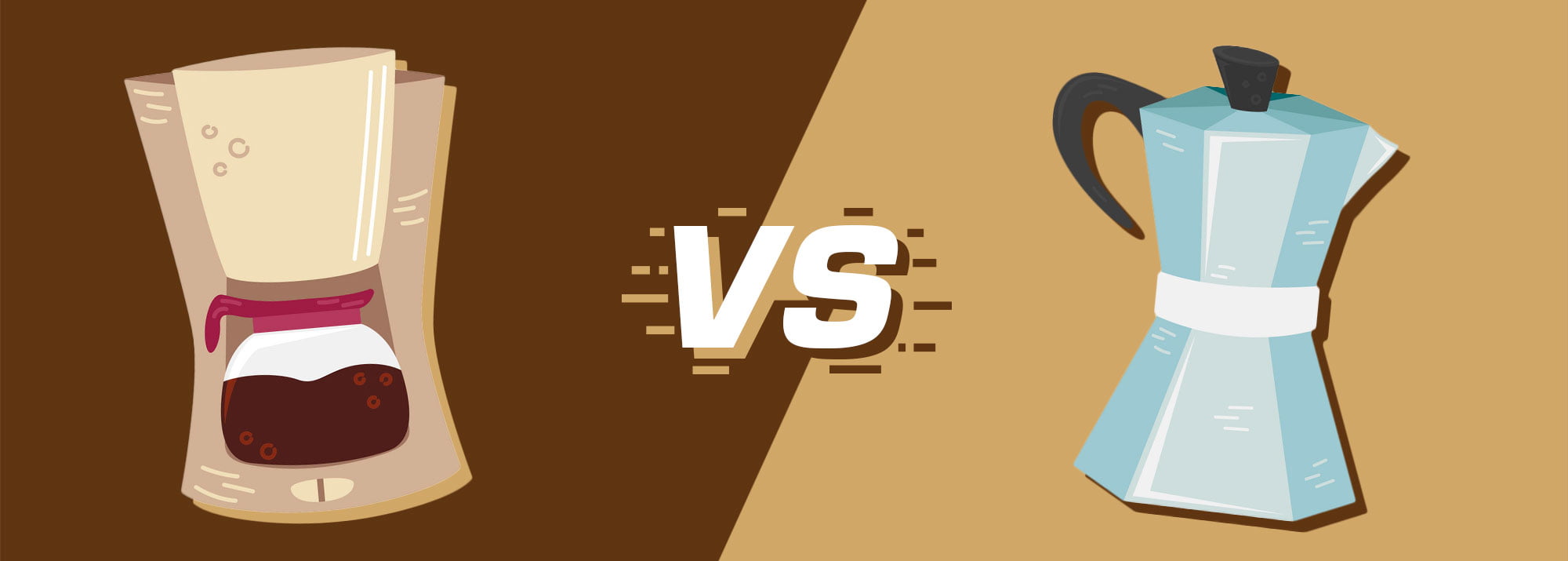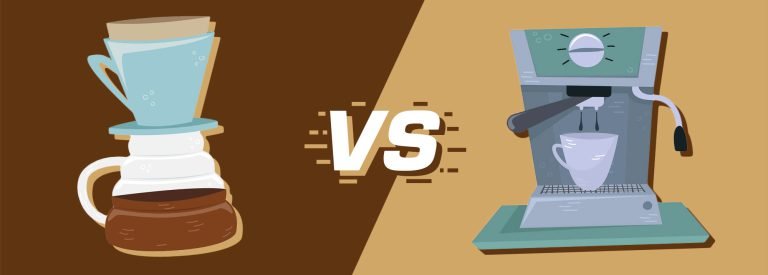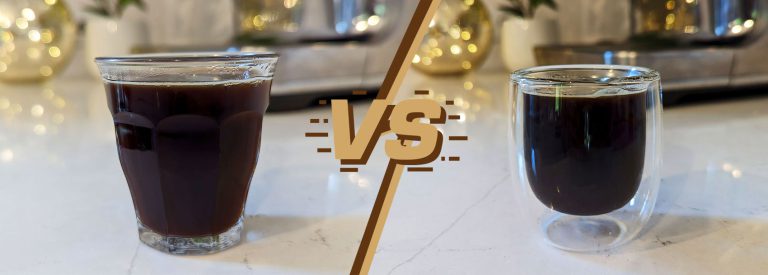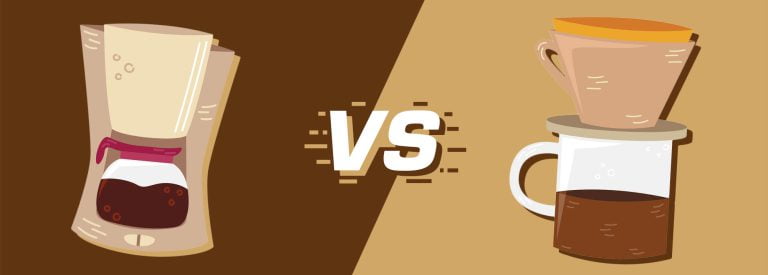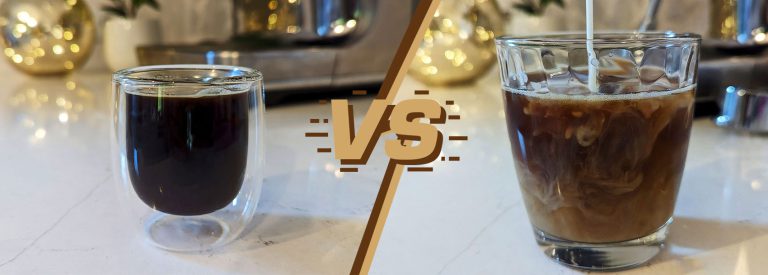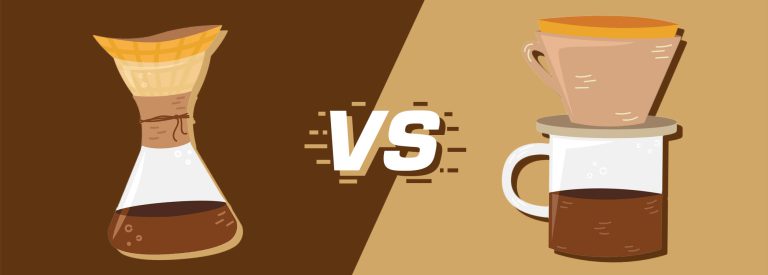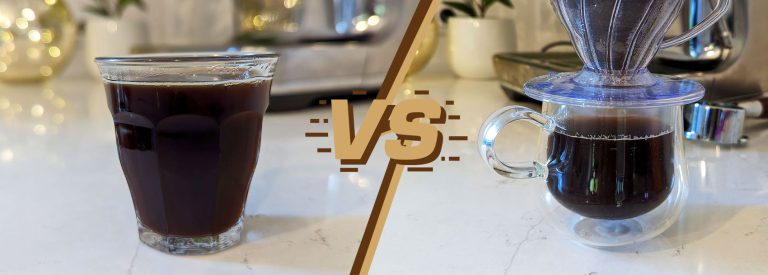Coffee vs Moka Pot: Which Brewing Method is For You?
One time, a friend of mine wanted a home espresso machine but couldn’t afford one yet, so he was stuck with two choices:
- the drip coffee machine which also automates brewing, and
- the Moka pot which works manually but creates espresso-like coffee.
This made me wonder: if I were to pit the two against each other, which one wins? Both methods have been around for a very long time and are still popular today, so which is “better”?
In this coffee maker face-off, I’ll go in-depth on both devices so you can make an informed decision on which suits your taste and lifestyle better: the concentrated brew of the Moka pot or your classic everyday drip coffee.
Comparing Drip Coffee & Moka Pot
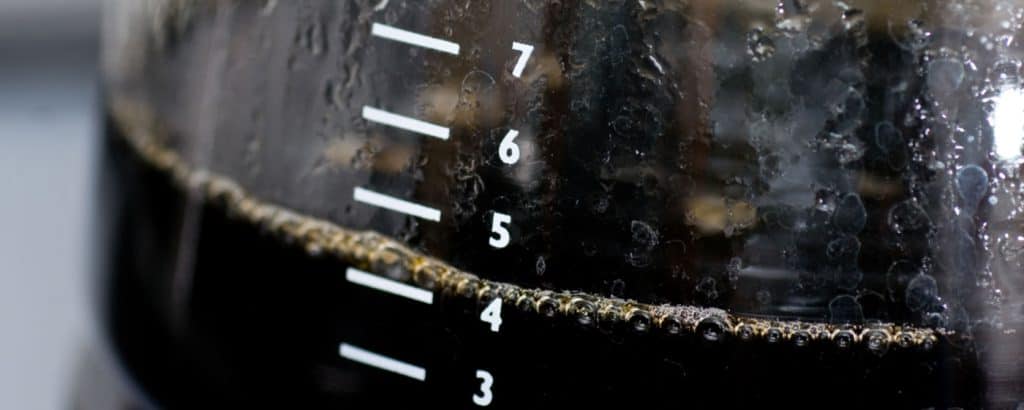
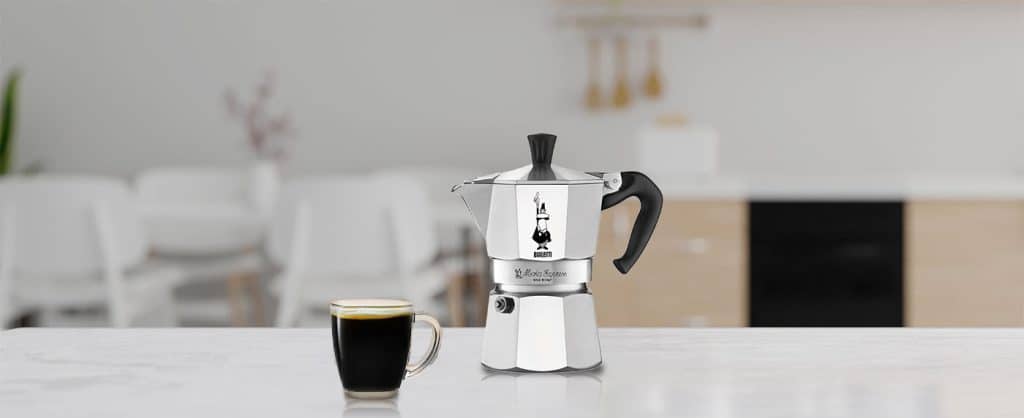
The drip coffee method is pretty straightforward. You add ground coffee beans into a filter that sits in a machine above a carafe or pot. Hot water is then poured over the grounds and drips through the filter down into the carafe or pot below. The automatic drip machine controls this process by keeping the water at an optimal temperature while controlling how fast it pours over the coffee grounds.
Meanwhile, the Moka pot is a stovetop method that makes strong coffee with a full-bodied taste similar to espresso (with the right tool and technique, you can even imitate that espresso crema with a Moka pot). It’s made up of three chambers: the bottom chamber where you put water, the middle basket where you put your ground coffee, and the top chamber where the brewed coffee is collected.
Once assembled, it’s put on low-medium heat until steam pressure builds (around 1.5 bars) and forces hot water through the coffee in the middle basket, filtering it up into the top chamber as the finished brew.
Here are the factors to consider when picking between the two brewing methods, followed by a detailed comparison of each feature:
| Features | Drip Coffee | Moka Pot |
|---|---|---|
| Taste & Flavor | Strong and bold flavor, smooth | Rich and full-bodied aroma |
| Strength | Little control over brewing | Strong and robust |
| Ease of Use | Simple and automated | Fairly easy |
| Brewing Speed | 5-10 minutes | At least 10 minutes |
| Versatility | Little control for brewing | Some control over brewing process |
| Durability & Portability | Some control over the brewing process | Durable and portable |
| Sustainability | Not an eco-friendly option | Very eco-friendly |
| Cost | Ranges from $25 to hundreds of dollars | More affordable at $15 to $70 |
Taste, Flavor, & Strength
Drip coffee and Moka pot coffee offer different drinking experiences in terms of taste and strength.
Drip coffee can have a strong and bold flavor, with a simple yet smooth body that is still tasty. The strength of your brew with drip machines depends on the coffee-to-water ratio and the roast level of the beans.
On the other hand, Moka pots produce rich and full-bodied aromatic coffee similar to espresso. This concentrated and robust brew is typically quite strong but deliciously balanced in terms of acidity and bitterness. Comparing the intensity of the two, Moka pot is way stronger than drip coffee.
Ease of Use
Next up, let’s look into how user-friendly these brewing methods are. Drip coffee has become popular due to its automated brewing process, making it simple and easy to use. Just aim for the right brewing factors such as using medium-coarse coffee grounds and maintaining the water temperature between 195°F to 205°F, though most machines would have this covered. Additionally, you get to pick from paper, metal, or cloth filters.
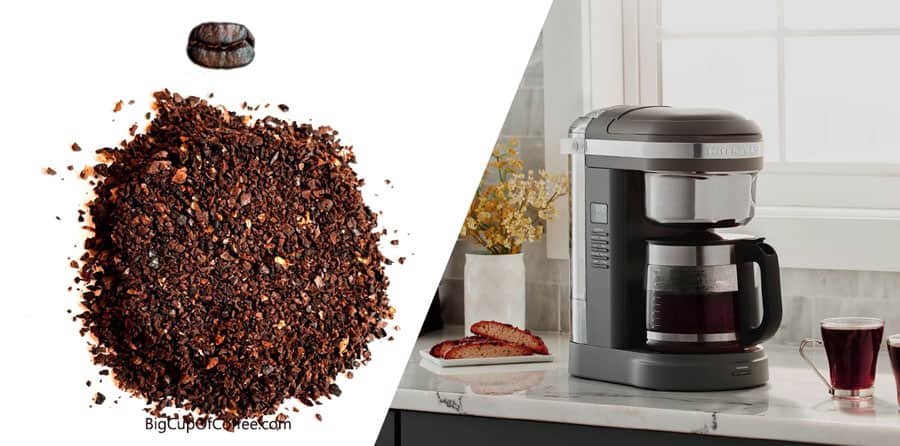
Meanwhile, Moka pot is also fairly easy to use with just a few steps required in the brewing process. This coffee maker works well even outdoors as long as you have a fire near you. The only thing you need to keep in mind while preparing coffee with Moka Pot is to choose medium-fine grind size beans and maintain around 212°F (100°C) water temperature.
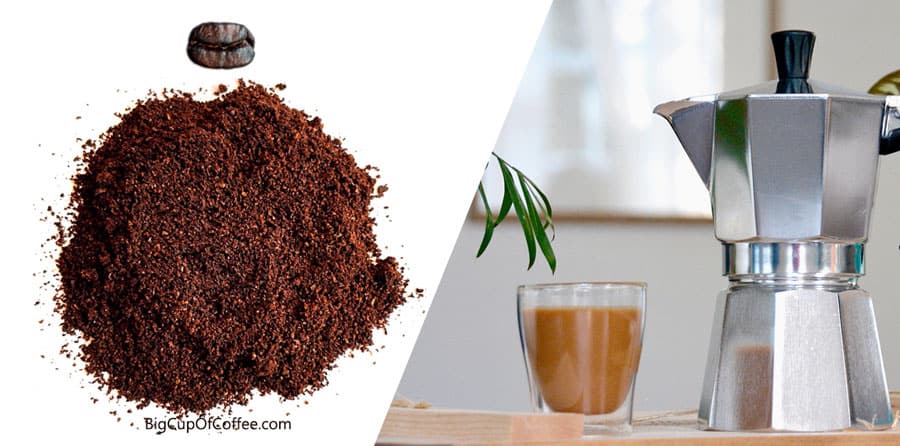
So if you’re looking for an effortless brew, a drip coffee machine is your best bet. Unlike Moka pots, there’s little room for error when you’re brewing with an automated machine that controls the temperature and pouring for you.
Brewing Speed
Onto the speed of these coffee makers. Drip coffee may be an automated process but it’s not as fast as espresso and coffee pod machines. It takes about 5 to 10 minutes to make drip coffee from grinding to brewing and cleaning up.
The Moka pot takes about this long as well, spanning approximately 10 minutes in total from grinding to tidying up. Cleaning the Moka pot is more time-consuming though, since the individual chambers must be rinsed with water and it can be tricky to remove all the coffee oils and grinds from its small crevices in the filter basket and filter.
Cleaning a drip coffee machine also takes some extra effort and time because of its removable parts. Personally, I’d say a drip coffee machine is easier to clean up after every use compared to disassembling and scrubbing the Moka pot.
Versatility
A brewing method’s versatility is important because it allows us to customize our cup of joe according to our specific personal preferences.
Basic drip coffee makers typically offer the least amount of control over the brewing process. You can usually only control the water-to-coffee ratio and the brewing time but other factors like water temperature, water dispersion, and pre-infusion are controlled by the machine. However, there are precision brewers, like the Breville Precision Brewer, that add more versatility to drip coffee.
Then there’s the Moka pot, which gives you some degree of control over your coffee. You can adjust the coffee-to-water ratio and grind size to some extent which will impact your final result.
When it comes to flexibility in sizes, both have wide ranges to choose from, catering to different needs.
Drip coffee makers typically come in six sizes:
- 4 cups
- 5 cups
- 8 cups
- 10 cups
- 12 cups
- 14 cups
Moka pot, on the other hand, offers even more options in terms of cup sizes. This variety allows you to select the perfect size for your needs, but the limitation is that you cannot half-fill a moka pot:
- 0.5-cup (40 ml)
- 1-cup (60 ml)
- 2-cup (90 ml)
- 3-cup (130 ml)
- 4-cup (190 ml)
- 6-cup (340 ml)
- 9-cup (540 ml)
- 12-cup (670 ml)
- 18-cup (810 ml)
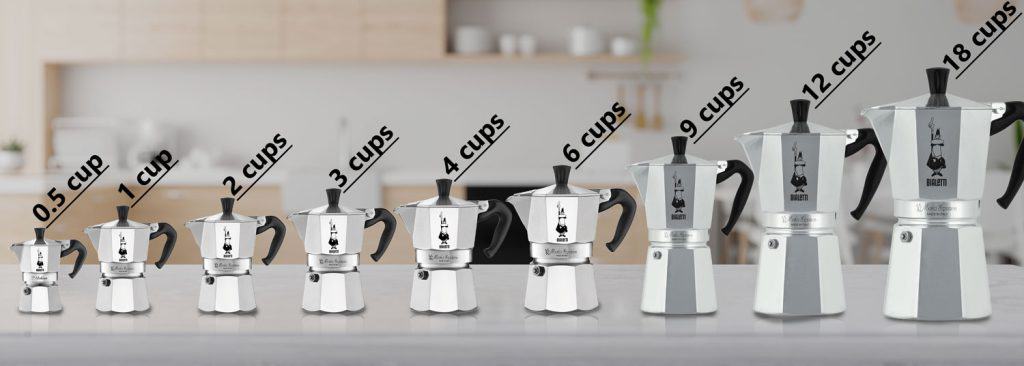
To summarize, these brewers may be lacking in versatility, but if it’s just between the two, then the Moka pot takes the win over drip coffee makers. Moreover, these pots also have more size options than the latter.
Durability and Portability
Discussing durability, drip coffee makers are made with stainless steel, plastic, or a mix of both while the carafe is typically built out of glass. While low end models have a life span of maximum few years, high-quality drip coffee machines are generally sturdy and would last longer than entry-level models. I explain why you really get what you pay for with cheap vs expensive drip coffee makers in this article.
Portability-wise though, while many home drip machines are compact and easy to move around the kitchen, they are not really designed for travel so they’re better off staying on your kitchen countertop.
In comparison, Moka pots are generally durable with aluminum or stainless steel bodies. Additionally, many models come in small-to-medium sizes, which makes them a great option if you’re looking for a portable solution.
It’s pretty clear that Moka pots are the more durable and portable option between the two brewers. As long as you know you’ll have a heat source, you can take and use your moka pot.
Sustainability
Finding ways for a sustainable cup of coffee is important because as the demand for coffee continues to grow each year, we need to make sure that the industry doesn’t leave any lasting harm to our planet.
Drip coffee makers consume electricity, making them less eco-friendly than other methods. In addition to the use of single-use filters, affordable but low-quality drip coffee machines tend to have short lifespans creating more waste at landfills.
In contrast, a Moka pot is a very eco-friendly brewer. It’s made with recyclable materials, does not necessarily use electricity (gas stove), and does not use disposable materials thanks to its built-in filter. They can also last very long, with the classic aluminum moka pots from Bialetti lasting decades with simple rubber gasket replacements from time to time.
In short, if you’re striving to minimize your carbon footprint in every cup of coffee you brew, the Moka pot is obviously the better choice than the drip coffee machine.
Cost
Another important factor to consider when picking a brewer is its value for money. Cheap drip machines start at prices of around $25. However, high-quality models are more expensive going up to hundreds of dollars in price, but this also means they last longer and are more versatile.
Moka pots are generally more affordable, with a price range of $15 to $70. As a bonus, unlike drip machines that need paper filters, a Moka pot operates with its own built-in filter so there are no recurring costs to worry about.
So if it’s affordability that you’re looking for in a brewer, then I recommend you choose a Moka pot. If you do like to go for drip coffee machines, you’d want to invest in a pricier model because lower-priced variants may cost more in the long run if you have to replace your unit more frequently.
Drip Coffee and Moka Pot – Weighing the Pros & Cons
Now that we’ve gotten a closer look at the features of each brewing method, here’s a quick overview of the pros and cons of Drip coffee and Moka pot so you can decide which one is for you:
| Brewing Method | Pros | Cons |
|---|---|---|
| Drip Coffee | – Quick and convenient to use – Affordable for an electric brewer – Does not require your attention when brewing | – Less control over the brewing process – Not portable – The use of electricity |
| Moka Pot | – Small and portable – Easy to use – Produces robust coffee similar to espresso | – Cleaning is a bit tougher – Limited control – Can easily have a bitter taste |
To know more about how drip coffee fares compared to other brewing methods, read my other comparison articles between drip and these methods:
Meanwhile, here are my comparisons between Moka pot and other brewers:
Conclusion
Wrapping things up, Moka pot has ticked more boxes compared to drip coffee machines. While the latter offers quick and convenient coffee, Moka pots win in terms of versatility, durability, portability, sustainability, and affordability.
Talking about taste, I also prefer the Moka pot because it creates a delicious espresso-like coffee that makes drip coffee dull in comparison (unless you like a smoother cup).
But that’s just my opinion. I want to know yours, so share in the comments which method you like better.

